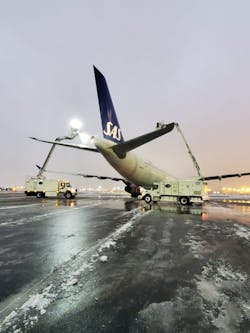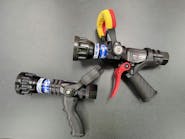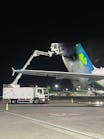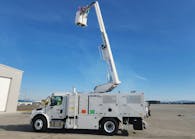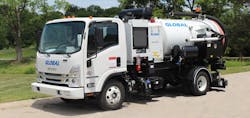Mallaghan’s TA8200 Deicer is the product of more than a decade of innovation.
In 2010, Mallaghan began building the TA8200 Deicer on the back of a partnership with a deicing company in Europe. The customer asked Mallaghan to take elements of premium quality deicers on the market at the time and bring it to the mid-market price point, according to Joe Griffith, commercial manager for Mallaghan. Now, the TA8200 offers a range of features to customize the rig to each operation’s unique needs.
“It’s a very simple deicer to operate and maintain,” Griffith says. “We tried to really boil it down to the basic elements and take known, reliable technologies and innovate them. We tried to keep key maintenance areas accessible. For example, our pump locker is spacious and allows easy access for maintenance of the pump systems. Our heater is a very innovative design – it’s a proprietary and exclusive design for Mallaghan. It’s an all stainless steel four burner system with both a primary and secondary burner ignition. So, should there be an issue with the primary ignition circuit for the heater, you can rely on the secondary ignition circuit. This results in an extremely reliable heater operation.”
The base model, TA8200, has a 47-foot working height standard that can service most small regional jets all the way up to larger wide-body mainline aircraft. The boom rotates 270 degrees with 29 feet of side reach. The deicer can hold 1,850 gallons of Type I deicing fluid and 320 gallons of Type IV anti-ice fluid and comes with an open basket and basket communication intercom system.
In addition to these standard features, companies can choose many optional features to add to the rig.
“Really the full gambit is single-operator technology, closed basket, forced air, extended boom, proportional mixing system to where the truck can mix glycol to exact percentages, on board options such as higher output heaters, larger tank configurations, different basket sizes. All are options customers can go through,” Griffith says.
According to Griffith, Mallaghan’s customers have positively received the TA8200 deicer but the company still works with them to make improvements on the rig.
“One of the big examples of the positive feedback was exceptional reliability,” Griffith says. “The rig started and ran reliably every time. It was easy to operate – one to two buttons get the thing up and running to start the day. One button ends the function at the end of the day. The rig is almost fully automated in that aspect.
“We do continuous improvement studies every year. Based on feedback and performance data, we may go to a new valve to improve reliability or to improve efficiency. It’s a continuously evolving product. We are constantly engaging with our customer base to gain feedback and measure the success of their operation over winter and from that we would take those into consideration and implement some improvements or some changes that would better suit the deicing operations around the world.”
Griffith says the company developed single-engine technology to meet customer requests for certain configurations and changed the design of the basket to meet customer needs.
“We’re trying to be very cognizant of any changes we make that we move the needle in the direction of reliability. We would never be the cheapest, but we would be some of the higher-quality rigs out there,” he notes.
The company is currently looking to launch its first single-engine rig soon. Mallaghan officials are also exploring green technology and carbon production technologies to improve the environmental impact of a deicing application.
The TA8200 deicer is in use around the world, according to Griffith.
“Its highest population is obviously in Europe – our headquarters are in Ireland,” he says. “We launched into North America last year, so in North America it’s being operated in airports like Newark and Louisville and then throughout Europe. China is also a major customer for us.”
Typically, these customers are major airlines and deicing service providers, according to Griffith. Airport authorities may buy deicing equipment and hire operators to use the technology as well.
“Given our rig is focused more on the larger size, FBOs that do larger commercial jets are also customers of Mallaghan, but typically if they’re doing small Cessnas our rig would be overkill,” he adds.
Griffith says the company asks customers key questions to determine what optional features are right for them.
“A lot of it is in their infrastructure. Does the station have its own blending system or are they bringing in pre-mixed glycol tanks? That will dictate whether they get onboard blending. We understand what type of snow they have. Forced air works really well in areas that have lighter snow. If you have a heavy, wet snow, forced air is still a great option but far more advantageous in cities that have lighter, fluffier snow.”
He says Mallaghan officials also try to understand what kind of aircraft customers will be working with to determine if the operation needs an extended boom. Other than that, it is often a matter of preference for the other optional features.
“Do they want single-engine or dual-engine? Do they want their operators out in the elements or do they want a closed basket? Where do they operate their trucks? Do they have a labor shortage? If they do are they trying to run a lean operation with the single-operator technology?” he notes.
“We really take the time to understand the customer and their exact needs to ensure our equipment not only meets, but exceeds their expectations in terms of performance and reliability.”
Griffith mentions the deicer does not require much maintenance. Every year, operators should inspect the heater elements and check the pumps and diaphragms to make sure they are in good working condition.
“We try to minimize the maintenance costs,” he says. “And then our service engineers based out of Atlanta go out and help support users with seasonal maintenance work on their deicers if they don’t have bandwidth available.”
Griffith also says the company has a 24-hour support line customers can call should they have any issues.